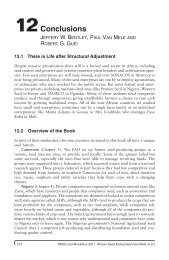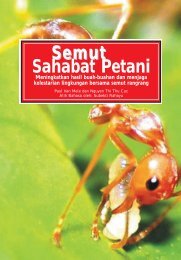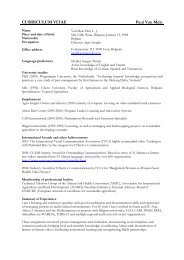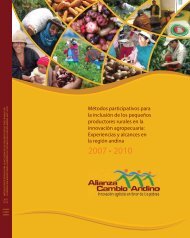Video-mediated farmer-to-farmer learning for sustainable agriculture
Video-mediated farmer-to-farmer learning for sustainable agriculture
Video-mediated farmer-to-farmer learning for sustainable agriculture
Create successful ePaper yourself
Turn your PDF publications into a flip-book with our unique Google optimized e-Paper software.
List of Tables<br />
Table 1. Respondents <strong>to</strong> survey on video use (n=505; August 29, 2011) ............................................ 7<br />
Table 2. Reasons <strong>for</strong> not or rarely using video (n=166) ........................................................................ 9<br />
Table 3. Ways of using <strong>farmer</strong> training videos (n=394) ...................................................................... 12<br />
Table 4. Priorities <strong>for</strong> future video productions (n=457) .................................................................... 20<br />
Table 5. Changes in rice yield and price per kg of parboiled rice after watching videos .................... 22<br />
Table 6. Changes in rice parboiling practices after watching video in Benin (n=200) ........................ 23<br />
Table 7. Comparison of various production models of <strong>farmer</strong>-<strong>to</strong>-<strong>farmer</strong> training videos ................. 25<br />
Table 8. Comparison of various dissemination models of <strong>farmer</strong>-<strong>to</strong>-<strong>farmer</strong> training videos 1 ........... 26<br />
Table 9. Priority content <strong>for</strong> a new web-based plat<strong>for</strong>m <strong>for</strong> <strong>farmer</strong> training videos (n=442) ............ 36<br />
List of Figures<br />
Figure 1. Frequency of video use <strong>to</strong> train <strong>farmer</strong>s (n=472) ................................................................... 8<br />
Figure 2. Usefulness of video <strong>to</strong> reach different audiences (n=453) .................................................. 10<br />
Figure 3. Perceived importance of local language training videos (n=438) ........................................ 17<br />
Figure 4. The zooming-in, zooming-out approach .............................................................................. 21<br />
Figure 5. Changes in use of botanicals and placement of seed s<strong>to</strong>rage container after women in<br />
Bangladesh watched videos (n= 1077). ............................................................................................... 21<br />
Figure 6. Changes in human and social capitals after women watched videos (n=180) ................... 22<br />
Figure 7. Frequency of people searching the web <strong>for</strong> agricultural training videos (n=442) ............... 29<br />
Figure 8. Perceived usefulness <strong>to</strong> establish a web-based plat<strong>for</strong>m <strong>for</strong> agricultural videos (n=442) .. 35<br />
Acknowledgements<br />
The on-line survey, this report and the susbsequent discussions on establishing Access Agriculture<br />
have benefitted greatly from inputs from Pierre-André Cordey and Markus Bürli (SDC); Peter-Erik<br />
Ywema and Emeline Fellus (SAI Plat<strong>for</strong>m); Kristin Davis (GFRAS); Josephine Rodgers and Phil Malone<br />
(Countrywise Communication); Jeffery Bentley (Agro-Insight); Chris Dabbs and James Wilkinson<br />
(Streaming Tank); and Markus Giger (University of Bern).<br />
<strong>Video</strong> <strong>for</strong> <strong>farmer</strong>s Agro-Insight, Oc<strong>to</strong>ber 2011 page 4







